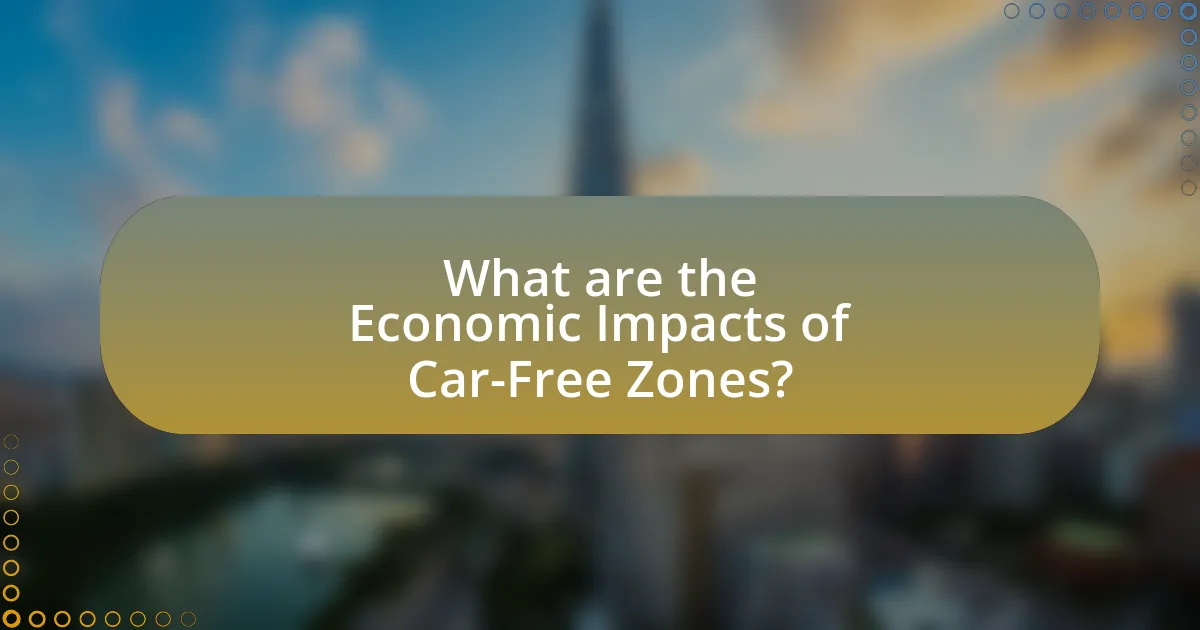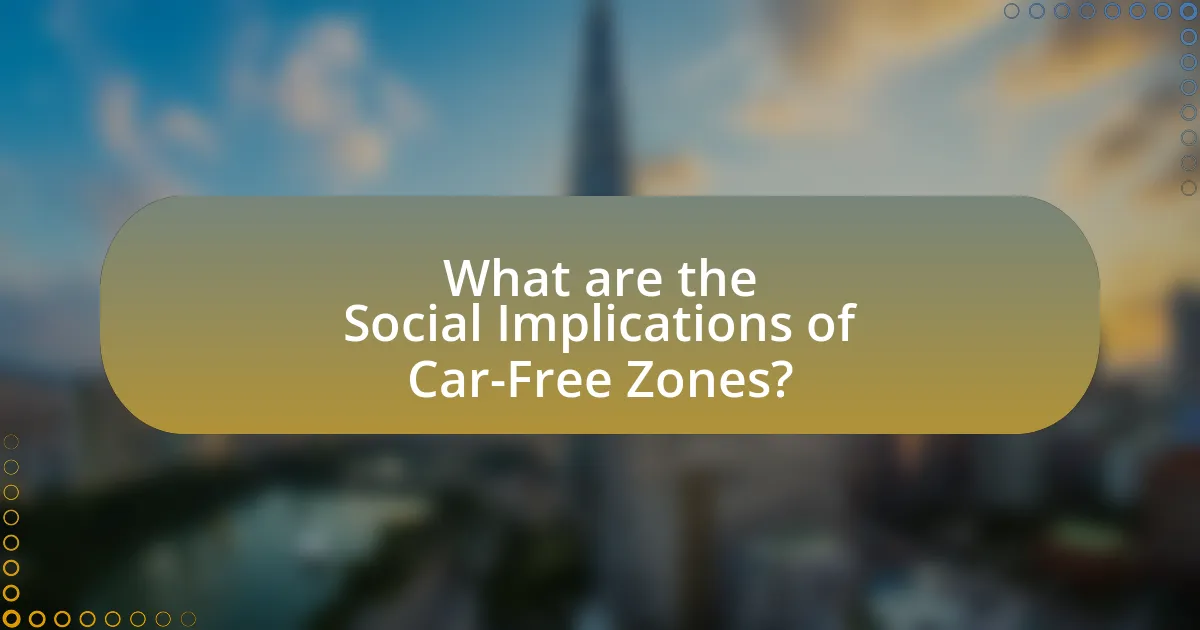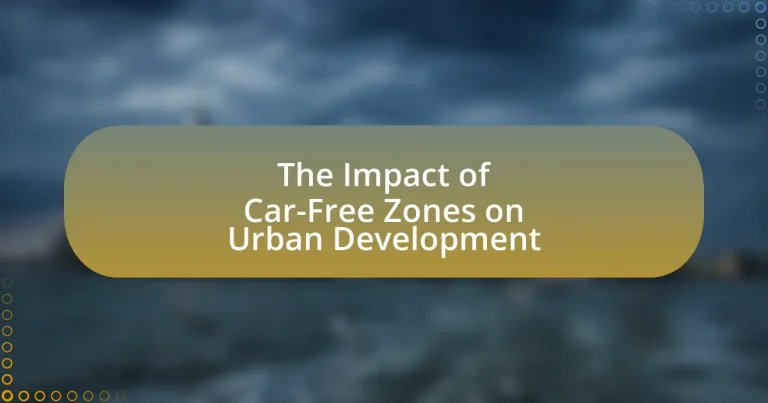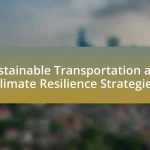Car-Free Zones are designated urban areas where motor vehicle access is restricted or prohibited, aimed at enhancing pedestrian and cyclist access while improving air quality and safety. This article examines the impact of Car-Free Zones on urban development, highlighting their influence on urban mobility, public health, and local economies. Key characteristics of effective Car-Free Zones include accessibility, safety, and community engagement, which contribute to increased foot traffic and economic growth. The article also addresses the environmental benefits, social implications, and challenges cities face when implementing these zones, along with strategies for successful design and community acceptance.

What are Car-Free Zones and Their Purpose?
Car-Free Zones are designated areas within urban environments where motor vehicles are restricted or prohibited, aimed at promoting pedestrian and cyclist access. The primary purpose of these zones is to enhance air quality, reduce traffic congestion, and improve safety for non-motorized road users. Evidence from cities like Oslo and Madrid shows that implementing car-free zones leads to a significant decrease in vehicle emissions and encourages the use of public transportation, thereby fostering a more sustainable urban ecosystem.
How do Car-Free Zones influence urban mobility?
Car-Free Zones significantly enhance urban mobility by reducing traffic congestion and promoting alternative transportation methods. These zones encourage walking, cycling, and the use of public transit, leading to a more efficient movement of people. For instance, cities like Oslo and Madrid have reported a decrease in car traffic by up to 30% in designated car-free areas, resulting in improved air quality and increased foot traffic in commercial districts. Studies indicate that such zones can lead to a 20% increase in public transport usage, demonstrating their effectiveness in reshaping urban mobility patterns.
What are the key characteristics of effective Car-Free Zones?
Effective Car-Free Zones are characterized by accessibility, safety, environmental benefits, and community engagement. Accessibility ensures that pedestrians, cyclists, and public transport users can easily navigate the area, promoting alternative modes of transportation. Safety is enhanced through reduced vehicle traffic, leading to fewer accidents and a more pleasant environment for all users. Environmental benefits include improved air quality and reduced noise pollution, contributing to healthier urban living conditions. Community engagement involves involving local residents in the planning process, fostering a sense of ownership and ensuring that the zone meets the needs of its users. These characteristics are supported by studies showing that cities with well-designed Car-Free Zones experience increased foot traffic, economic growth in local businesses, and enhanced quality of life for residents.
How do Car-Free Zones affect pedestrian and cyclist safety?
Car-Free Zones significantly enhance pedestrian and cyclist safety by reducing vehicle traffic in designated areas. Studies indicate that these zones lead to lower accident rates, as evidenced by a report from the European Commission, which found that pedestrian injuries decreased by 40% in areas where car access was restricted. Additionally, the presence of more cyclists in these zones promotes a safer environment through increased visibility and awareness among all road users. The implementation of Car-Free Zones also encourages urban design that prioritizes walking and cycling infrastructure, further contributing to overall safety improvements.
Why are cities implementing Car-Free Zones?
Cities are implementing Car-Free Zones to reduce traffic congestion and improve air quality. These zones encourage walking, cycling, and the use of public transportation, leading to decreased vehicle emissions. For instance, cities like Oslo and Madrid have reported significant reductions in air pollution levels and increased pedestrian activity since establishing such zones. Additionally, studies indicate that Car-Free Zones can enhance urban livability by creating safer, more attractive public spaces, which in turn can boost local economies through increased foot traffic.
What environmental benefits do Car-Free Zones provide?
Car-Free Zones provide significant environmental benefits, primarily by reducing air pollution and greenhouse gas emissions. These zones limit vehicular traffic, leading to decreased levels of harmful pollutants such as nitrogen oxides and particulate matter, which are known to adversely affect public health and contribute to climate change. For instance, a study conducted in Oslo, Norway, found that the implementation of a car ban in the city center resulted in a 35% reduction in nitrogen dioxide levels within the first year. Additionally, Car-Free Zones promote biodiversity by creating safer habitats for urban wildlife and encouraging the growth of green spaces, which can absorb carbon dioxide and improve urban ecosystems.
How do Car-Free Zones contribute to public health?
Car-Free Zones contribute to public health by reducing air pollution and promoting physical activity among residents. The elimination of vehicle traffic in designated areas leads to lower emissions of harmful pollutants, which can decrease respiratory and cardiovascular diseases. For instance, a study conducted in Oslo, Norway, found that air quality improved significantly after the implementation of a car ban, resulting in a 30% reduction in nitrogen dioxide levels. Additionally, these zones encourage walking and cycling, which are associated with increased physical activity, thereby reducing obesity rates and related health issues. Research from the University of California, Berkeley, indicates that urban areas with pedestrian-friendly environments see a 20% increase in physical activity levels among residents.

What are the Economic Impacts of Car-Free Zones?
Car-free zones positively impact local economies by increasing foot traffic, enhancing retail sales, and improving property values. Studies show that areas with car-free zones experience a rise in pedestrian activity, which can lead to a 20-30% increase in sales for local businesses. Additionally, property values in these zones often appreciate due to the enhanced quality of life and reduced pollution, making them more attractive to residents and investors. For instance, a study conducted in Oslo found that the introduction of car-free areas led to a 10% increase in property prices within the vicinity. These economic benefits demonstrate the effectiveness of car-free zones in fostering vibrant urban environments.
How do Car-Free Zones affect local businesses?
Car-Free Zones generally have a positive impact on local businesses by increasing foot traffic and enhancing the overall shopping experience. Studies, such as one conducted by the European Commission, indicate that pedestrian-friendly areas can lead to a 30% increase in retail sales due to higher visibility and accessibility for customers. Additionally, these zones often attract more visitors, as they create a more pleasant environment free from vehicle congestion, which can further boost local commerce.
What types of businesses thrive in Car-Free Zones?
Retail businesses, particularly those focused on food and beverage, entertainment, and local crafts, thrive in Car-Free Zones. These areas attract foot traffic, encouraging consumers to explore shops and restaurants without the distraction of vehicles. For instance, studies have shown that pedestrian-friendly environments can increase retail sales by up to 30%, as seen in cities like Copenhagen and Barcelona, where car restrictions have led to a vibrant street life and boosted local economies. Additionally, businesses that offer outdoor seating or unique experiences, such as street performances or markets, also benefit significantly from the increased visibility and accessibility that Car-Free Zones provide.
How do Car-Free Zones influence property values?
Car-Free Zones generally increase property values due to enhanced livability and reduced traffic congestion. Studies indicate that properties located within or near Car-Free Zones often see a rise in demand, as these areas attract residents and businesses seeking a more pedestrian-friendly environment. For instance, research conducted by the University of California found that property values in areas with pedestrian-only streets increased by an average of 10-15% compared to similar neighborhoods without such zones. This increase is attributed to improved air quality, reduced noise pollution, and greater accessibility to amenities, all of which contribute to a more desirable living environment.
What are the costs associated with implementing Car-Free Zones?
The costs associated with implementing Car-Free Zones include infrastructure modifications, enforcement expenses, and potential economic impacts on local businesses. Infrastructure modifications often require significant investment in public transportation systems, pedestrian pathways, and cycling facilities, which can range from thousands to millions of dollars depending on the area. Enforcement expenses arise from the need for monitoring and regulating vehicle access, which may involve hiring additional personnel or installing surveillance systems. Additionally, local businesses may experience short-term revenue declines during the transition period, although studies, such as one by the European Commission, indicate that long-term benefits often outweigh these initial costs through increased foot traffic and improved urban environments.
What funding sources are available for establishing Car-Free Zones?
Funding sources for establishing Car-Free Zones include government grants, public-private partnerships, and community crowdfunding initiatives. Government grants often come from local, state, or federal transportation departments aimed at promoting sustainable urban development. Public-private partnerships can leverage investments from businesses that benefit from increased foot traffic in car-free areas. Community crowdfunding initiatives allow residents to contribute financially to the creation of these zones, fostering local engagement and support. These funding mechanisms have been successfully utilized in various cities to implement car-free initiatives, demonstrating their viability and effectiveness in urban planning.
How can cities measure the economic impact of Car-Free Zones?
Cities can measure the economic impact of Car-Free Zones by analyzing changes in local business revenues, property values, and tourism rates. For instance, studies have shown that pedestrian-friendly areas often see a 20-30% increase in retail sales due to higher foot traffic. Additionally, property values in these zones can rise by 10-15% as demand for residential and commercial spaces increases. Cities can also utilize surveys to assess visitor spending patterns and conduct before-and-after studies to quantify economic shifts. These methods provide concrete data that demonstrate the positive economic effects of implementing Car-Free Zones.

What are the Social Implications of Car-Free Zones?
Car-free zones significantly enhance social interactions and community engagement by creating pedestrian-friendly spaces. These zones encourage walking, cycling, and social gatherings, which can lead to increased local business activity and a stronger sense of community. Research indicates that cities implementing car-free zones, such as Oslo and Barcelona, have reported improved public health outcomes due to reduced air pollution and increased physical activity among residents. Additionally, studies show that these areas often experience a rise in social cohesion, as people are more likely to interact in shared public spaces.
How do Car-Free Zones promote social interaction?
Car-Free Zones promote social interaction by creating safe, pedestrian-friendly environments that encourage people to gather and engage with one another. These zones eliminate vehicle traffic, reducing noise and air pollution, which fosters a more inviting atmosphere for social activities. Research indicates that areas with reduced car access see increased foot traffic, leading to higher rates of social encounters and community events. For instance, a study conducted in Oslo, Norway, found that pedestrianized areas experienced a 30% increase in social interactions, demonstrating the effectiveness of Car-Free Zones in enhancing community connectivity.
What role do Car-Free Zones play in community building?
Car-Free Zones play a significant role in community building by fostering social interactions and enhancing public spaces. These zones encourage pedestrians and cyclists, which leads to increased foot traffic and opportunities for community engagement. Research indicates that areas with Car-Free Zones often see a rise in local businesses and community events, as people are more likely to gather in accessible, vibrant environments. For instance, a study by the European Commission found that cities implementing Car-Free Zones experienced a 30% increase in local commerce and a 20% increase in community events, demonstrating their effectiveness in strengthening community ties.
How do Car-Free Zones affect accessibility for different demographics?
Car-Free Zones enhance accessibility for various demographics by promoting pedestrian movement and reducing vehicle congestion. These zones often lead to improved safety and comfort for pedestrians, cyclists, and individuals with mobility challenges. For instance, studies show that areas with Car-Free Zones experience a 30% increase in foot traffic, benefiting local businesses and encouraging social interactions. Additionally, research from the European Commission indicates that such zones can significantly improve air quality, which positively impacts public health, particularly for vulnerable populations like children and the elderly. Thus, Car-Free Zones create more inclusive urban environments by facilitating easier access to amenities and services for diverse groups.
What challenges do cities face when creating Car-Free Zones?
Cities face significant challenges when creating Car-Free Zones, primarily including resistance from residents and businesses, logistical issues in urban planning, and concerns about traffic displacement. Resistance often stems from the perception that such zones limit accessibility and economic activity; for instance, a survey in London indicated that 60% of local businesses feared a drop in customers due to car restrictions. Logistical issues arise in redesigning infrastructure to accommodate pedestrians and cyclists, which can be costly and time-consuming. Additionally, traffic displacement can lead to increased congestion in surrounding areas, as vehicles are rerouted, complicating the overall traffic management strategy. These challenges necessitate careful planning and community engagement to ensure successful implementation of Car-Free Zones.
How can cities address opposition to Car-Free Zones?
Cities can address opposition to Car-Free Zones by engaging the community through transparent communication and participatory planning processes. By involving residents in discussions about the benefits of Car-Free Zones, such as improved air quality and enhanced public spaces, cities can foster a sense of ownership and acceptance. Evidence from cities like Oslo, which implemented a Car-Free Zone in its city center, shows that public support increased after residents experienced the positive impacts, including reduced traffic congestion and increased pedestrian activity. Additionally, cities can provide alternative transportation options, such as improved public transit and bike-sharing programs, to alleviate concerns about accessibility. This approach has been validated by studies indicating that cities with robust alternative transport systems see higher acceptance rates for Car-Free initiatives.
What strategies can be employed to ensure successful implementation?
To ensure successful implementation of car-free zones, cities should adopt a multi-faceted strategy that includes stakeholder engagement, clear communication, and robust infrastructure planning. Engaging stakeholders such as local businesses, residents, and transportation experts fosters community support and addresses concerns, which is crucial for acceptance and compliance. Clear communication about the benefits, such as reduced traffic congestion and improved air quality, helps to inform the public and gain their backing. Additionally, robust infrastructure planning, including the development of alternative transportation options like cycling paths and public transit, ensures that residents have viable means to navigate the area without cars. Evidence from cities like Oslo, which implemented a car ban in its city center, shows a 35% reduction in traffic and a significant increase in pedestrian and cyclist activity, demonstrating the effectiveness of these strategies in achieving successful implementation.
What best practices should cities follow when designing Car-Free Zones?
Cities should prioritize pedestrian accessibility and safety when designing Car-Free Zones. This involves creating wide sidewalks, installing adequate lighting, and ensuring clear signage to guide foot traffic. Additionally, cities should incorporate green spaces and seating areas to enhance the environment and encourage social interaction. Evidence from cities like Copenhagen shows that well-designed Car-Free Zones can increase foot traffic by up to 40%, boosting local businesses and improving community well-being. Furthermore, engaging the community in the planning process ensures that the needs and preferences of residents are met, leading to higher acceptance and usage of these zones.


